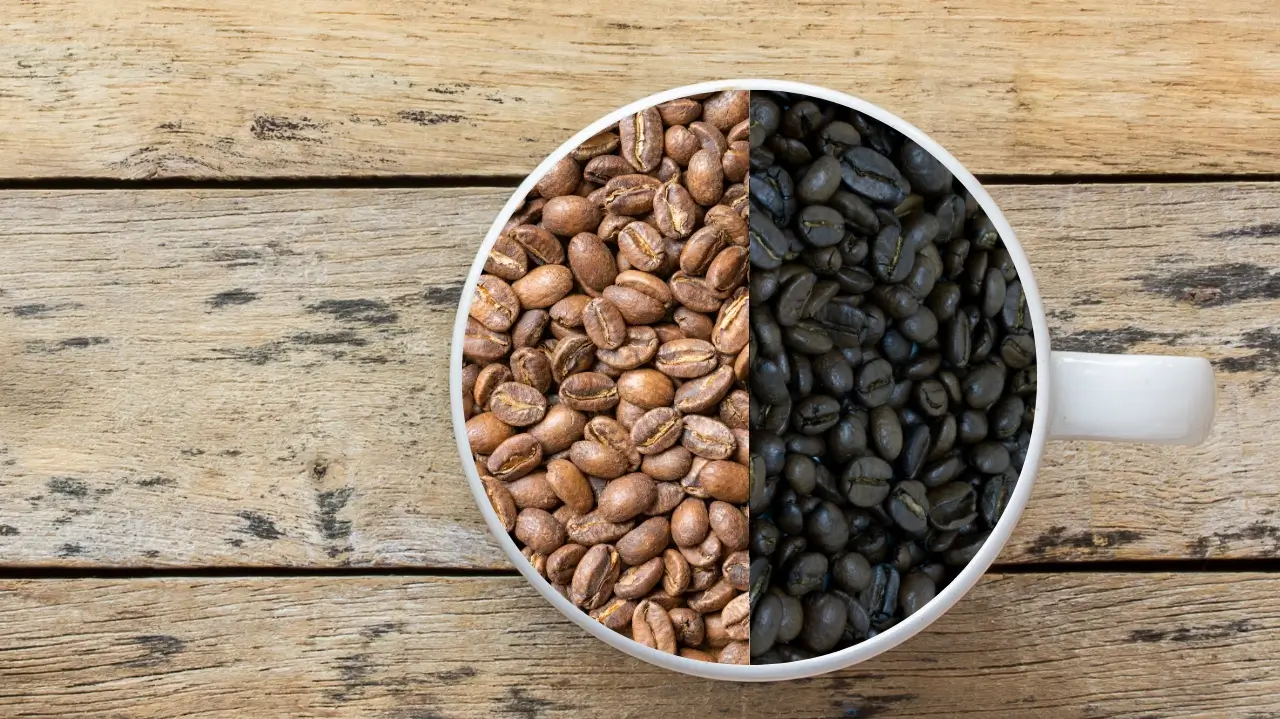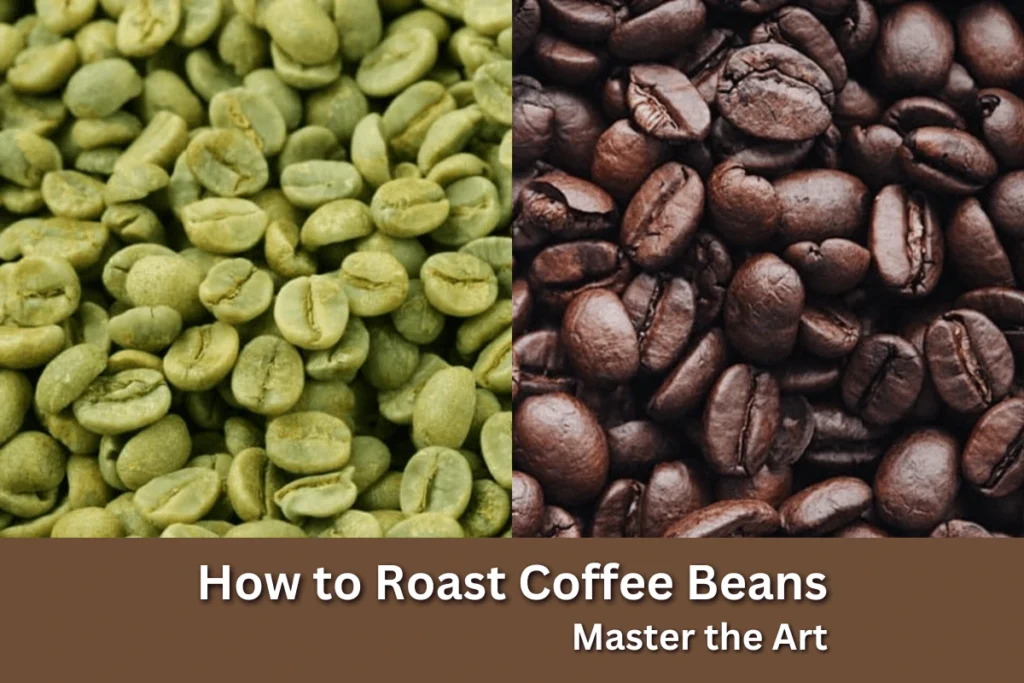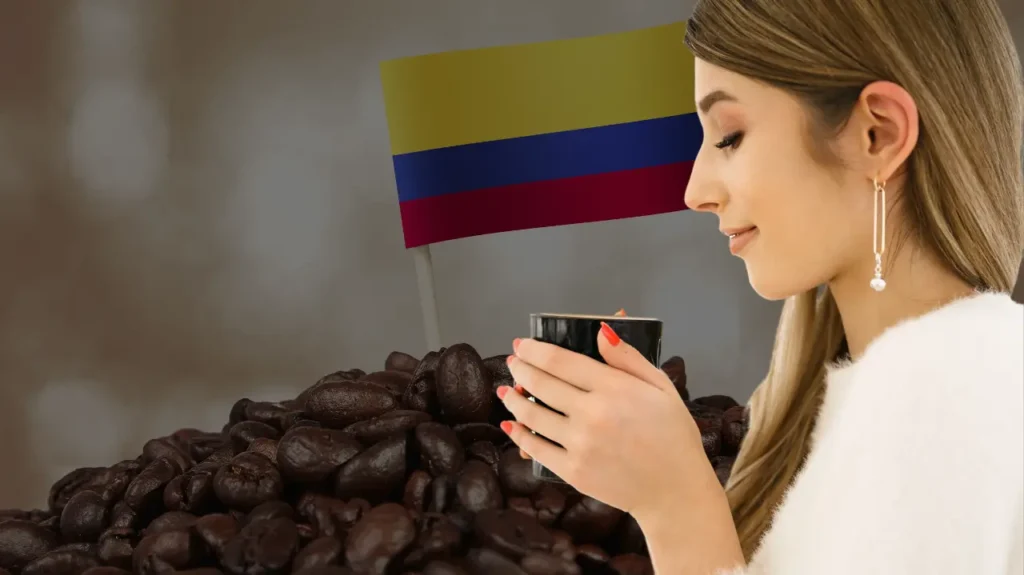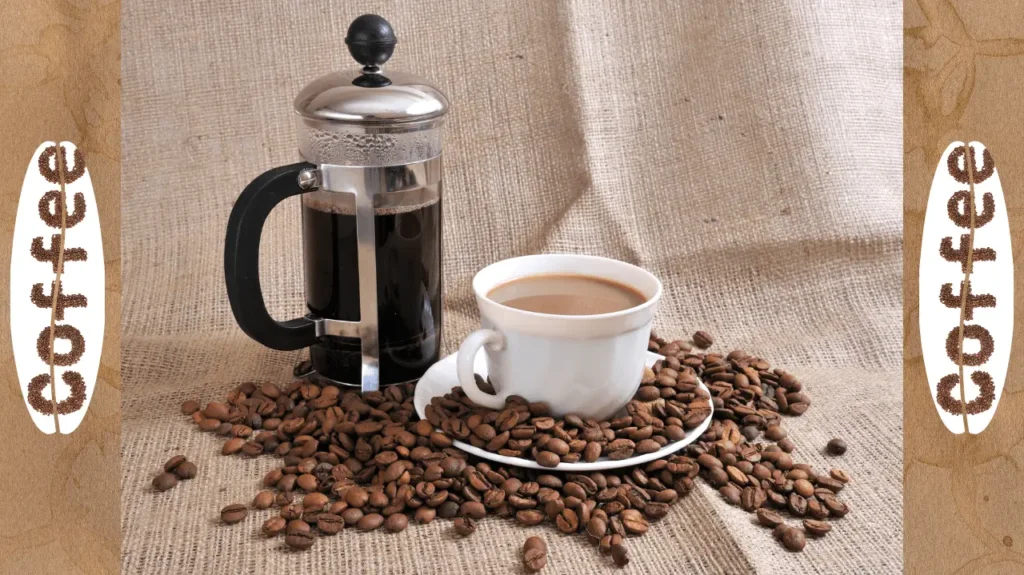Ever freeze at the coffee counter, eyes darting between “light roast” and “dark roast”? You’re not the first.
That split-second choice hides a world of flavour secrets, ones most drinkers never uncover. Is one stronger? Sweeter? Does caffeine vanish in the Roast? Let’s spill the beans.
This isn’t just about brown vs. black. It’s about fire meeting beans and chemistry becoming magic. Light roasts whisper stories of soil and sunshine.
Dark roasts roar with charcoal and courage. We’ll strip away myths (spoiler: dark Roast isn’t caffeine-free) and show you how heat rewrites a bean’s DNA.
Understanding Coffee Roasts
Coffee roasts aren’t just labels; they’re flavour blueprints. Imagine raw green beans as blank canvases.
Roasting is the artist’s brushstroke, turning muted greens into vibrant browns while unlocking hidden stories.
Light or dark? That choice dictates whether you’ll taste the bean’s birthplace or the roaster’s fiery signature.
For those curious about decaf options, explore how decaf coffee differs from regular coffee.
At its core, roasting is controlled chaos. Heat coaxes out oils, cracks beans open, and decides which flavours live or die.
Light roasts freeze the bean’s youth, capturing crisp, floral highs. Dark roasts push beans into adulthood, where caramelized sugars and smoke take over.
For a deeper dive into bold roasts, explore French roast coffee.
The Roasting Process
Roasting coffee isn’t just heating beans; it’s a high-stakes dance between fire and time. Green beans, fresh off the farm, taste like grass and wet paper.
Roasters transform them through precise heat control, turning bland seeds into flavour bombs.
Light and dark roasts aren’t siblings; they’re distant cousins. The split happens early. Light roasts hit temperatures around 385°F, quitting just after the first crack.
That’s when beans explode like popcorn, releasing steam and unlocking bright, zesty flavours. Dark roasts? They’re the daredevils.
Roasters crank heat past 430°F, riding the second crack, a deeper, oil-sizzling snap, where sugars burn into smoky depths.
Heat doesn’t just change colour; it rewrites the bean’s chemistry. Light roasts preserve natural acids and fruity esters, like capturing a grape before it becomes wine.
Dark roasts smash those compounds, swapping them for caramelized sugars and bitter pyrazines. It’s the difference between biting a fresh cherry and licking the char off a grilled steak.
Pro roasters obsess over seconds. Stop too soon, and the bean stays grassy. Roast too long, and it tastes like ash.
Every degree shifts the flavour; light roasts highlight the bean’s birthplace, while dark roasts scream about the roaster’s boldness.
Here’s the kicker: caffeine isn’t roasted away. Light beans stay dense, packing slightly more caffeine per scoop.
Dark beans lose mass but gain volume, so your “strong” dark roast cup might actually be weaker.
Characteristics of Light Roast Coffee
Light roast coffee is where beans bare their souls. Those pale, matte-brown beans? They’re like unedited manuscripts, raw, honest, and packed with quirks.
Roasters pull them off the heat just after the first crack, preserving every fingerprint of their origin.
Taste a light roast from Kenya, and it’s a tangy punch of blackcurrant and tomato vine. Colombian? Expect a clean cane sugar sweetness with a hibiscus twist.
The magic lies in the Roast’s restraint: high-altitude beans thrive here, their natural acidity and floral notes surviving the light kiss of heat.
Acidity in light roasts isn’t a flaw; it’s the heartbeat. It’s the tartness of a ripe raspberry, not the bite of vinegar.
This vibrancy fades fast in darker roasts, but here, it’s front and centre. Pair it with a buttery croissant, and the contrast is a chef’s kiss.
Body-wise, think sparkling wine, not syrup. Light roasts glide over your tongue, leaving a tea-like crispness.
That’s why methods matter: a V60 pour-over amplifies clarity, while an AeroPress teases out subtle fruit without bitterness.
Even cold brew works; steep light roast coarse grounds overnight for a juicy, iced citrus bomb.
Caffeine? Yes, light roasts hide a tiny edge. Since heat puffs up beans, dark roasts weigh less per scoop. Blonde coffee fans might recognize this sneaky caffeine kick.
But here’s the catch: light roasts don’t hide flaws. A poorly processed bean? It’ll taste like grass clippings. Over-roast it by 10 seconds?
The apricot notes vanish. That’s why top roasters treat light roasts like rare gems, sourced meticulously and roasted with stopwatch precision.
Forget “beginner’s coffee.” Light Roast is the explorer’s brew, a flavour safari where every sip maps a farm’s soil and sun.
Dark roasts shout; light roasts whisper secrets.
Characteristics of Dark Roast Coffee
Dark roast coffee is the campfire of the coffee world, smoky, bold, and unapologetic. Those oily, near-black beans?
They’ve been roasted past the second crack, where heat forces natural oils to the surface like sweat on a grill. This isn’t subtlety; it’s a flavour rebellion.
Bite into a dark roast, and you’re tasting the Roast, not the bean. Colombian or Ethiopian, it hardly matters.
The fire dominates, swapping origin stories for charred caramel, dark chocolate, and a whisper of woodsmoke.
Maillard reactions work overtime here, turning sugars into deep, toasty notes that linger like a bonfire’s echo.
Acidity? Ghosted. Roasting burns off those bright, fruity acids, leaving a mellow base that’s easier on sensitive stomachs.
What remains is a rounded, almost savoury low end; think blackstrap molasses, not lemon zest. It’s why dark roast pairs with cream and sugar like jeans and leather jackets.
The body goes full throttle. Syrupy and heavy, it coats your tongue like melted fudge. Perfect for cutting through steamed milk in lattes, where lighter roasts might drown.
Brew it as espresso, and you get that classic crema, a golden-brown foam that’s bitter, sweet, and endlessly photogenic.
Learn how to craft similar intensity with Nespresso iced coffee.
Caffeine myths cling here. Yes, dark roast beans have less caffeine per bean. But grind them, and you’ll need more volume to fill your portafilter.
Net result? Your dark roast latte packs nearly the same punch as a light roast pour-over. The buzz is in the dose, not the Roast.
Historically, dark roasts hid cheap beans. Today, they’re a craft. Top roasters use high-quality Arabica, roasting slowly to avoid ashy flavours.
Italy’s espresso culture swears by them; think of that thick, creamy shot dipped in a flaky cornetto.
But there’s a catch: those shiny oils turn rancid fast. Store dark beans in airtight containers and use them within two weeks.
Unlike light roasts, they won’t flirt with floral notes or fade into stale bitterness.
Love bitter drinks? Dark Roast is your IPA of coffee. It’s for those who crave a cigar-like richness, a flavour that stands up to a chocolate torte or a greasy breakfast sandwich.
Comparing Light and Dark Roast Coffee
Now that we’ve looked at the characteristics of each, let’s compare them side by side to understand how they differ, using a table for clarity:
| Aspect | Light Roast | Dark Roast |
| Color | Light brown, dry surface | Dark brown, oily surface |
| Flavor Profile | Bright, acidic, fruity, complex, origin-focused | Bold, rich, caramelized, uniform, bitterness |
| Acidity | Higher, lively taste | Lower, smoother, less bright |
| Body | Lighter, thinner mouthfeel | Fuller, heavier, substantial mouthfeel |
| Caffeine Content | Slightly more per bean, minimal difference | Slightly less per bean, negligible difference |
| Roasting Temperature | 385–410°F, stops after first crack | >430°F, often reaches second crack or beyond |
| Roasting Time | Shorter | Longer |
| Moisture Content | More, denser coffee | Less, less dense coffee |
| Best Brewing Methods | Pour-over, French press | Espresso, drip coffee, French press |
This table highlights the key differences, but let’s dive deeper into some aspects:
What’s the Difference Between Light Roast and Dark Roast Coffee
Light and dark roasts aren’t just opposites; they’re different languages. Light Roast speaks in dialects: a Kenyan bean chirps with blackcurrant tartness, a Costa Rican hums with honeyed papaya.
Dark Roast? It’s a universal shout of “roasted.” Whether the beans are from Brazil or Sumatra, you’ll taste cocoa nibs and charred oak, the origin story drowned in fire’s roar.
The divide starts at the Roast’s peak. Light roasts preserve chlorogenic acids, compounds that spark bright, citrusy zing.
Dark roasts torch those acids, swapping them for melanoidin’s (those toasty, bitter-sweet molecules born from caramelized sugars).
It’s the difference between a fresh-picked grape and a raisin left in the sun.
Health-wise, both roasts fight inflammation, but their weapons differ. Light roasts guard chlorogenic acid, an antioxidant linked to lower blood pressure (studies suggest coffee’s health benefits).
Dark roasts lose some of these but gain melanoidin; think of them as the “grilled” antioxidants studied for gut health perks.
Neither’s a superhero, but your pick might sway with your gut: light’s acidity can irritate sensitive stomachs, while dark’s smoother profile goes down easier.
If you’re concerned about acidity, mushroom coffee offers a low-acid alternative.
Here’s the twist: light roasts oxidize faster. Those delicate flavours? They fade within weeks, like cut fruit left out.
Dark roasts, stripped of nuance, stay consistent longer, their oils acting as a shield. It’s why gas stations’ coffee tastes the same worldwide: dark Roast’s uniformity survives neglect.
For drinkers, it’s a choice between adventure and comfort. Light Roast is a vineyard tour, with each sip a soil snapshot.
Common Misconceptions
Let’s grind through the rumours. “Dark roast has more caffeine”, a lie thicker than espresso crema. Truth?
Light roasts win by a hair per bean, but here’s why the myth sticks: dark Roast’s boldness tricks us into equating flavour with potency.
It’s like assuming spicier salsa has more tomatoes. Curious about other caffeine myths? See how coffee pods measure up.
“Dark roast is stronger.” Strong how? If “strong” means bitter, sure. But caffeine “strength” depends on the dose, not Roast.
A light roast pour-over with 20g beans packs more buzz than a dark roast espresso with 18g. Strength is a numbers game, not a roast level.
Some claim dark roasts are “overcooked.” Not if done right. Burnt beans? A sign of lazy roasting.
Craft dark roasts to balance smokiness without ash; think of a seared steak vs. a charcoal briquette.
Another myth: “Light roast is acidic and harsh.” Actually, underdeveloped beans taste sour. A well-roasted light brew balances acidity with sweetness, like a ripe mango.
Dark roast fans confuse brightness with bite; it’s vibrancy, not violence.
Preferences split like espresso shots. Light roast loyalists chase terroir, the soil, altitude, and processing that shape flavours.
Dark roast devotees? They’re after the roaster’s craft, where heat mastery overshadows origin. It’s like choosing between a vineyard tour and a whiskey barrel aging room.
Here’s a twist: dark roast oils don’t mean smoother. To some, that slickness feels like motor oil. Others crave it for mouthfeel. Light Roast’s crispness?
Refreshing to some, jarring to others. There’s no “right” cup, just your tongue’s bias.
And no, dark Roast isn’t “for old people.” Italy’s youth slam dark espresso shots daily. Light Roast’s rise? A millennial-driven trend, not a maturity test.
The real divide? Control. Light Roast demands perfect beans and precise brewing. Dark Roast forgives, bending into lattes or surviving stale grinders.
Which One is Better? A Subjective Choice
Forget “better.” Coffee isn’t a competition; it’s a conversation. Light Roast? A whispered secret from a Colombian hillside. Dark Roast? A shout from a Rome espresso bar.
Neither wins. They’re different languages, and fluency depends on your cravings.
Think of it like music. Light Roast is jazz, unpredictable, layered, and full of solos. Dark Roast is classic rock, comforting, anthemic, all power chords.
Your mood picks the playlist. Crave adventure? Light Roast’s wild strawberry and jasmine notes will thrill.
Need a hug in a mug? Dark Roast’s cocoa and toasted hazelnut deliver.
Generational divides? Overblown. Yes, nonnas in Sicily swear by caffè scuro, but Tokyo’s Gen Z sips light roast cold brew between meetings.
Yet trends shift: specialty shops now lure older drinkers with honey-processed light roasts, while Gen Xers nostalgic for ’90s diner coffee chase dark Roast’s familiarity.
Culture writes the rules. In Ethiopia, light-roasted Yirgacheffe is sipped black, honouring centuries-old traditions.
In France, dark roast café noir pairs with butter croissants, a ritual as fixed as the Eiffel Tower. Your roots, or your wanderlust, might sway your cup.
Here’s the truth: your “best” Roast depends on the when, not just the what. Mornings may demand Dark Roast’s cannonball kick.
Afternoons?
A floral light roast to dance on your tongue. And let’s not forget your gear: a $15 drip machine butchers delicate light roasts but cozies up to dark’s boldness.
Quality changed the game. Pre-2000s, dark Roast hid Robusta’s rubbery flaws. Today, heirloom Arabica beans shine in light roasts, a flex of modern farming and roasting tech.
But dark Roast isn’t lazy; it’s a style like charcoal artists who turn blank canvases into moody masterpieces.
So, cheat. Keep both. Use dark for espresso martinis and light for iced pour-overs. Rotate bags like seasonal wardrobe swaps.
How to Choose the Right Roast for You
Picking your Roast isn’t about rules; it’s about tuning into your gut (and your grinder). Let’s ditch the decision paralysis and brew some clarity.
Taste Preference
Your palate’s the boss here. Do you lick lemon wedges or sneak dark chocolate squares? Light roast dances with tangy, tea-like vibes; think blood orange acidity or a whiff of jasmine.
Dark Roast? It’s campfire nights in a mug: bitter cocoa, charred cedar, maybe a flicker of caramelized sugar. If bitterness feels like a cozy blanket, go dark.
If you crave flavours that shift like a Spotify playlist, light your jam.
Brewing Method
Your gear’s not innocent. Light Roast is a diva; she needs a slow pour-over or coffee urn to hit those high notes. Use a blade grinder? She’ll screech.
Dark Roast’s the chill bandmate. It’ll rock an espresso machine, survive a drip pot, and even slum it in a hotel room Keurig.
Milk drinkers listen up: dark Roast’s boldness cuts through steamed milk like a hot knife. Light Roast in a latte? It’s a whisper in a thunderstorm.
Experiment
Play the field. Grab single-origin light and dark roasts from the same farm. Brew them side by side.
Notice how light-roasted Ethiopia Yirgacheffe bursts with bergamot while its dark-roasted twin drowns in smoke.
Try Dark Roast as a cold brew; its bitterness mellows into chocolate milk vibes. Burned your tongue on light Roast’s acidity?
Add a salt pinch to the grounds; it tames the bite. Coffee’s a lab, and you’re the mad scientist.
Origin
Geography’s stamped on light roasts. Colombian beans? They’re all about balanced caramel and apple. Kenyan? Punchy tomato acidity and blackcurrant.
Light roasting lets soil and the sun steal the spotlight. Dark Roast? It’s a passport blackout. That Indonesian Sumatra becomes a smoky enigma, its earthy funk blurred by the Roast.
If you’re the type who geotags your Instagram coffee, a light roast is your muse.
The final tip? Rotate. Keep a light roast for lazy Sunday pour-overs and a dark roast for Monday morning espressos. Your mood swings, your coffee shouldn’t.
Conclusion
Light or dark? The answer’s in your mug, not a manual. One’s a vibrant postcard from a coffee farm’s soil; the other’s a smoky sonnet penned by fire.
Your preference? It’s as personal as your playlist.
Forget “right” or “wrong.” Coffee’s a journey. Tomorrow, you’ll crave Light Roast’s lemony spark. Next week, dark Roast’s chocolate depth.
That’s the thrill; your taste buds write the rules.
So, here’s your move: Grab a bag of each. Brew them side by side. Laugh at how the same bean becomes two entirely different drinks.
Text your friend: “Dude, try this.” Debate. Change your mind. Change it again.




